![]()
Photos by Harry Wagner
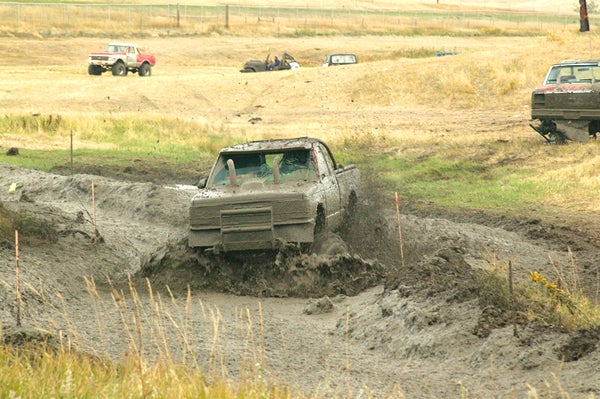 |
| Big lifts, big tires and big power are all very helpful in running in deep goo like this. Stock vehicles should never attempt mud of this depth unless they have a buddy with a tow truck. |
Mud is easily the messiest terrain, and it can also be one of the most treacherous you encounter. It can be soupy, slick, gooey, or sticky. Different consistencies of mud will require different techniques to conqueror. Even if you know the consistency, it is difficult to gauge exactly how the deep mud is or know what is lurking beneath the surface. We would not advise traveling through anything but the shallowest of mud puddles in a stock vehicle, particularly if it is shod with all-season tires. Doing so could result in tow truck fees high enough to feed a third world country for a year.
Sky High- A suspension that can handle a lot of power without axle wrap is more important that articulation in the mud. Ground clearance is a factor, as you want to keep anything under the vehicle from pushing mud, if at all possible. Often times rubber is added to the undercarriage or inner fenders to keep mud out of the engine bay and reduce drag. Mud flaps and conveyor belts are some of the least expensive, most rugged options. This is trick often employed by those who participate in mud drags, but recreational mud boggers tend to prefer to raise their vehicle above the slop. Big lifts, Rockwell axles, and tractor tires are all commonplace at mud pits.
If your vehicle is not sky high, make sure that at least your air intake is. Ingesting dirty water or mud into your engine will surely cause it an untimely death. Some mud boggers route the air intake into the cab but this creates a lot of additional noise and heat in the interior and isn’t suitable for a daily driver. A snorkel or pre-filter are cheap insurance though when it comes to feeding your engine clean air.
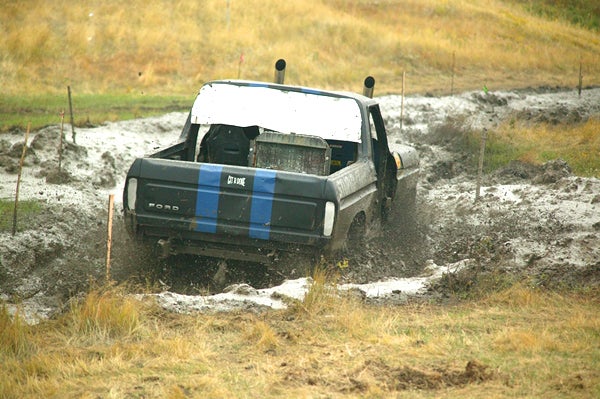 |
The high RPMs and loads common in the mud make cooling system failures common. If your cooling system has a weak link, a good mud pit will find it for you. Dedicated mud runners often relocate their radiator to the rear to keep it free from mud and running cool. |
Keep It Cool- Another benefit to that sky high suspension is that it keeps the engine bay out of the mud. Blown radiators and hoses are the most common failures witnessed in the mud. Front mounted radiators are easily clogged by deep, thick mud, forcing many dedicated mud boggers to relocate their radiator the rear of the vehicle. At the very least consider covering the radiator temporarily while travelling through mud, and be certain to keep an eye on the temperature gauge. Mud provides a large amount of resistance and prolonged mudding can wreak havoc on torque convertors and engines. Consider a large auxiliary transmission cooler, high flow water pump, and electric fan if you spend a lot of time in the mud.
Check the Depth- When it comes time to travel through the mud, use a stick to check the depth and consistency before entering the pit. Probe for obstacles hidden beneath the surface such as logs, rocks, or other trail debris that could cut a tire or impede progress. You can also get an idea if the bottom of the bog is soft and deep or firm and relatively shallow. Hip waders can be useful for this purpose and they can keep you from getting dirty when the time comes to do extraction.
Go First- Mud is one situation where it may not be beneficial to let someone else go first, particularly if they have larger tires than you. Often times the vehicle will dig holes, and if those holes are big enough you will find yourself resting on the frame or axles when your tires enter them. If you are the one with the large tires, you can often stay in the ruts and dig to the bottom of the hole to continue all the way through. Otherwise it is wise to try and hug the edge of the ruts in order to maintain traction and forward momentum.
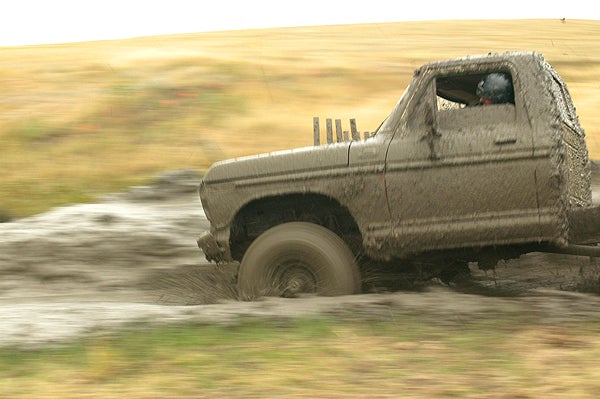 |
| Momentum is key to getting through the deepest mud. Just make certain you are not going so fast you lose control of your vehicle. |
Keep Up Momentum- Regardless whether you are the first through the bog or not, it is necessary to keep your momentum up in order to get to the other side. This means being prepared. Once you start into the mud, it isn’t the time to think about whether you have locked the hubs or not, or whether you have a tow strap with you in case you do not make it. Anticipate the necessary speed and shift the transfer case and transmission (for those with manual trannies) into the necessary gear to get to the other side. Unlike rocks or steep descents, where speed can work against you, drivers typically want to propel their vehicle across the mud as fast as possible while maintaining control. If you have selectable lockers, consider locking the rear differential for added traction, but leave the front differential open in order to aid steering input. If you have open differentials, consider adding a rear locker or spool. This will provide one of the biggest increases in capability for a reasonable price.
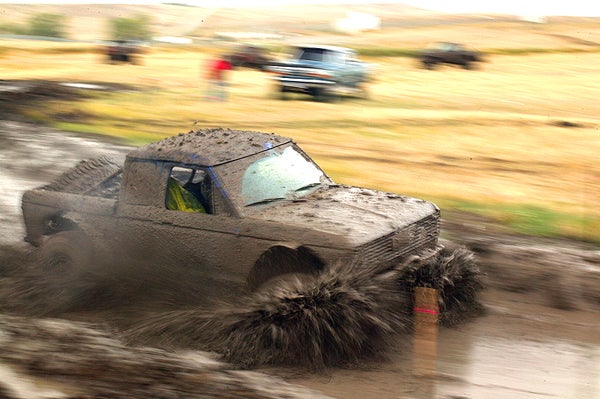 |
Interco’s Super Swamper Boggers are the most aggressive DOT approved tire on the market. They howl like a banshee on the pavement and are heavier than lead, but in the mud they are hard to beat. Only very aggressive (and non-DOT) tractor tires offer more traction. |
Aggressive Tires- In mud the more aggressive the tire the better. The tradeoff with aggressive mud tires is that they are very loud on the pavement, can provide a rough ride and wear quickly. The attributes that make a good mud tire are 180 degrees out of phase with what you want on the street. A compromise is necessary if you drive your vehicle both on the street and in the mud. For the ultimate in traction, Interco Super Swamper Boggers reign supreme, followed by their TSL brethren. These tires use a tread design with deep lugs and large, open voids. They also use thick, bias-ply sidewalls that can withstand massive abuse from tree roots, rocks, and other sharp objects that might be lurking beneath the surface of the mud. Skinnier tires offer a higher contact pressure and are best suited to relatively shallow mud with a firm bottom. Deeper mud calls for a wider tire that will float over the surface of the mud without sinking to the bottom.
Saw the Wheel- The key to maintaining forward progress in the mud is for the tires to keep biting; flinging the mud backwards and your vehicle forward. If you don’t have the most aggressive tires, saw the wheel back and forth slightly as you progress through the bog. This has a dual effect; it helps to clean out the tread on the outside edges of your tires, and it will allow those lugs to bite into the sides of ruts. Just make certain to keep your thumbs outside of the steering wheel. Even with power steering, if the ruts are too deep your vehicle is going to take you wherever those ruts point.
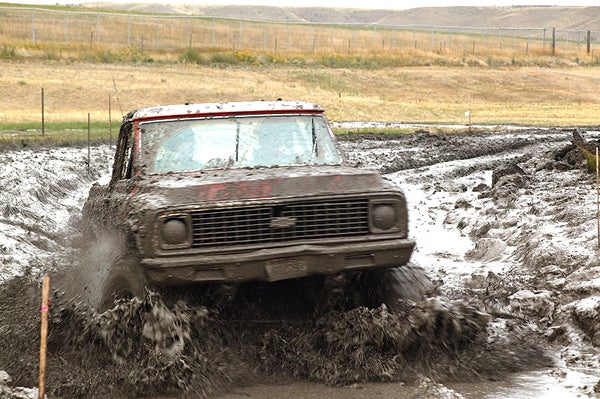 |
Make certain to start the windshield wipers and lock the hubs BEFORE you enter the mud to prevent any unexpected surprises. |
Use Windshield Wipers- One of the biggest challenges to driving in the mud is seeing where you are going with mud splashing all around you and your vehicle. The windshield wipers should be started before you enter the pit in order to maintain visibility, and we have even seen some savvy wheelers spray the whole vehicle with non-stick cooking spray in order to keep the mud from sticking. Others keep the washer fluid motor running full-time to help dilute the mud and aid in visibility.
Don't Dig- When forward momentum stops, it is time to let up on the gas. You want to avoid spinning the tires and digging holes. Often times this just clogs the tires up with mud and leaves you sitting on the framerails. When forward momentum stops, let off the gas. Often times you can put the vehicle in reverse and back up, if even a few inches, then try to continue forward again. This see-saw action will get you out of many situations. You may find that each time you backup and go forward you gain a little distance. This is progress.
Cleanup- After your mud romping excursion, it is wise to thoroughly clean your vehicle before the mud has a chance to harden and dry. A lawn sprinkler placed under the vehicle for an extended amount of time will loose large chunks and takes minimal effort. Pay particular attention to brake components, starter motors, and alternators as they can become lodged with mud that will severely shorten their lifespan. Dried mud inside the back of your rims can also affect your tire balance.
Muddy water can get into differentials and gear boxes if breather tubes are not placed up high, out of the water. If this happens it will cause the gear oil to break down and burnt bearings, gears, and synchros can result. Check your fluids regularly and change them at the first sign that they have ingested any water.


 Your Privacy Choices
Your Privacy Choices